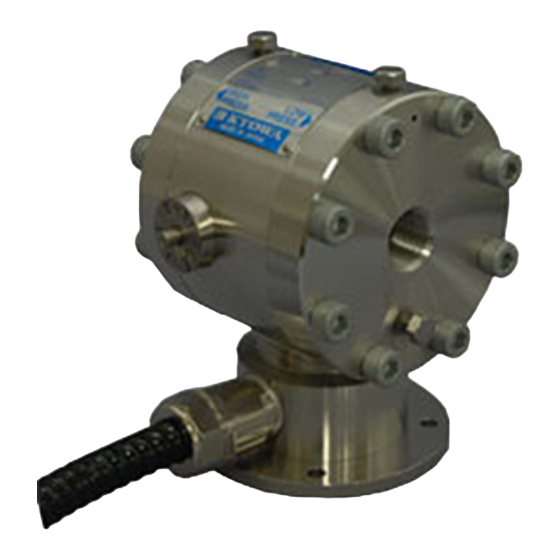
Advertisement
Quick Links
PDU-A Differen tial Pressu re Tran sd u cer INSTRUCTION MANUAL
Thank you for purchasing this KYOWA product. Before using it,
read this instruction manual carefully. Also, keep the manual
within easy reach so that you can refer to whenever necessary.
Specifications and dimensions described in this manual could be
changed without notice. Please visit our website for the latest
version.
1. Callin g th e o p erato r's atten tion
The following cautionary symbols and headlines are used to invite
the operator' s attention. Be sure to observe the accompanying
precautions in order to safeguard the operator and preserve the
performance of the instrument.
Improper handling may cause serious injury to
W arn in g
the operator.
Improper handling may cause deleterious
Cau tio n
effects to the operator's body.
Cautions are given to invite the operator' s
Cau tion
attention, in order to avoid instrument failure
or mal- function.
2. Im p o rtant n otice
Unless specified, the transducers must not be used under
hydrogen environment.
3. Safety p recau tio n s
Avoid pressure in excess of the allowable overload rating, or the
instrument can explode.
Avoid contact of a projecting object with the sensing surface, or
the latter may crack to result in the transducer' s explosion.
Use the specified tightening torque. Improper tightening torque
may cause the transducer' s explosion.
If excessive pressure could possibly occur, provide protective
casing around the transducer installation, in order to safeguard
the operator.
Dismount the transducer only after the applied pressure has
been completely removed.
SUS316L and SUS304 (JIS G4303) is used where the
transducer contacts a liquid. Avoid application of the transducer
to a corrosive liquid or gas.
W arnin g
Cau tio n
4. Han d lin g precau tio n s
Cau tio n
Do not disassemble the transducer.
Avoid tension on the cable.
Make sure that the bending radius of cable is longer than 6
times of a diameter of the cable.
Materials used are: SUS316L for diaphragm and flange;
SUS304 for air escape; fluoro rubber for O- ring.
Do NOT use the transducer with any chemical listed below.
1. Halide 2. Hydrochloric acid 3.Formic acid 4. Oxalic acid
5. Hydrogen sulfide 6. Absolute ammonia 7.Caustic soda
8. Acetone 9. Acetic acid 10. Nitrous acid 11. Sulfuric acid
The transducer' s mainframe is connected with the shielding
wire of the cable.
Use the transducer as it is in ordinary cases. However if it is
necessary to disconnect the shielding wire, remove the
mounting plate and disconnect the shielding jumper wire
inside the terminal box.
The transducer is provided with overload protection which
prevents damage in case of an overload (up to 30MPa) on
either the high or low pressure side. The zero point is however
caused to drift more or less. If such is the case, take zero
balance anew.
Use line pressure of less than 30MPa
Use bridge voltage of lower than 15V.
To use the transducer as a pressure transducer, use the high
pressure inlet.
Avoid damage to the diaphragm when cleaning or removing
foreign matters from it.
To mount the flange to the mainframe, tighten the bolt using
torque of 40N ・ m (reference value: 400kgf ・ cm).
IM-T-114G J ul 2022
.
Advertisement

Subscribe to Our Youtube Channel
Summary of Contents for KYOWA PDU-A
- Page 1 IM-T-114G J ul 2022 PDU-A Differen tial Pressu re Tran sd u cer INSTRUCTION MANUAL Thank you for purchasing this KYOWA product. Before using it, 4. Han d lin g precau tio n s read this instruction manual carefully. Also, keep the manual within easy reach so that you can refer to whenever necessary.
- Page 2 M5× 25 as shown in the figure below. 7.1 Connect the transducer to a measuring instrument. (For applicable pipe 50A) 7.2 When using a measuring instrument other than KYOWA, connector plug as follows. Shield wire is connected to the case.
- Page 3 If the measured values are different from the descriptions of 0.07 the inspection sheet, the cause may be a trouble. In this case, contact your nearest KYOWA representative for necessary inspection Cau tio n To measure insulation resistance, apply a voltage lower than If it desired to eliminate pulsating noise, select a smaller number 50V to the insulation resistance tester.
- Page 4 Approx. 6kg Mounting Screw Rc1/2, female Compliance Directive 2011/ 65/ EU, (EU) 2015/ 863 (10 restricted substances) (RoHS) [NOTE] Products with CE Marking are compliant European RoHS Directive. ◆Accessories Test Data Sheet Instruction manual 1 (this book) W ebsite : www.kyowa-ei.com...
- Page 5 IM-T-114G 2022.7 P D U -A 型 差圧変換器─取扱説明書 こ のた びは本製品を お買い上げいた だき ま し て , あ り がと う 4. 使用上のご 注意 ご ざ いま す。 ご 使用の前には, 本書を 必ずお読みく ださ い。 ま た , お読みにな っ た あ と はいつで も 見ら れる と こ ろ に必ず 注意...
- Page 6 5. 取り 付け 6. 配管 5.1 本体の取付板を 利用し て , M 6 ねじ 4 本で固定し ま す。 6.1 圧力導入口の配管 圧力導入口は Rc1/2 めねじ にな っ て おり ま す。 R1/2 おねじ ( ねじ 込み形継手) を 使用し て く ださ い。 その際,漏れを 防止する た めにねじ 部に適切な シ ール材を 塗布する...
- Page 7 8. 測定 10. 換算 8.1 高圧・ 低圧側の二つのバルブが閉じ て いる こ と を 確認後, 10.1 出力値を 圧力に 換算する に は 検査成績書の 校正係数を 高圧・ 低圧の二つの圧力を , それぞれのバルブのと こ ろ ま 用いま す。 10.2 ひずみ測定器を 使用する 場合は, 出力がε( ×10 で導入し て く ださ い。 ひず...
- Page 8 ±0. 02%/℃以内 PDU-A-100KP 100kPa ±0. 2%RO以内 ±0. 2%RO以内 PDU-A-200KP 200kPa PDU-A-500KP 500kPa ±0. 01%RO /℃以内 ±0. 01%/℃以内 PDU-A-1M P 1M Pa ±0. 25%RO以内 ±0. 25%RO以内 PDU-A-2M P 2M Pa ◆性能 定格容量 上記表参照 非直線性 上記表参照 ヒ ス テ リ シ ス...















Need help?
Do you have a question about the PDU-A and is the answer not in the manual?
Questions and answers